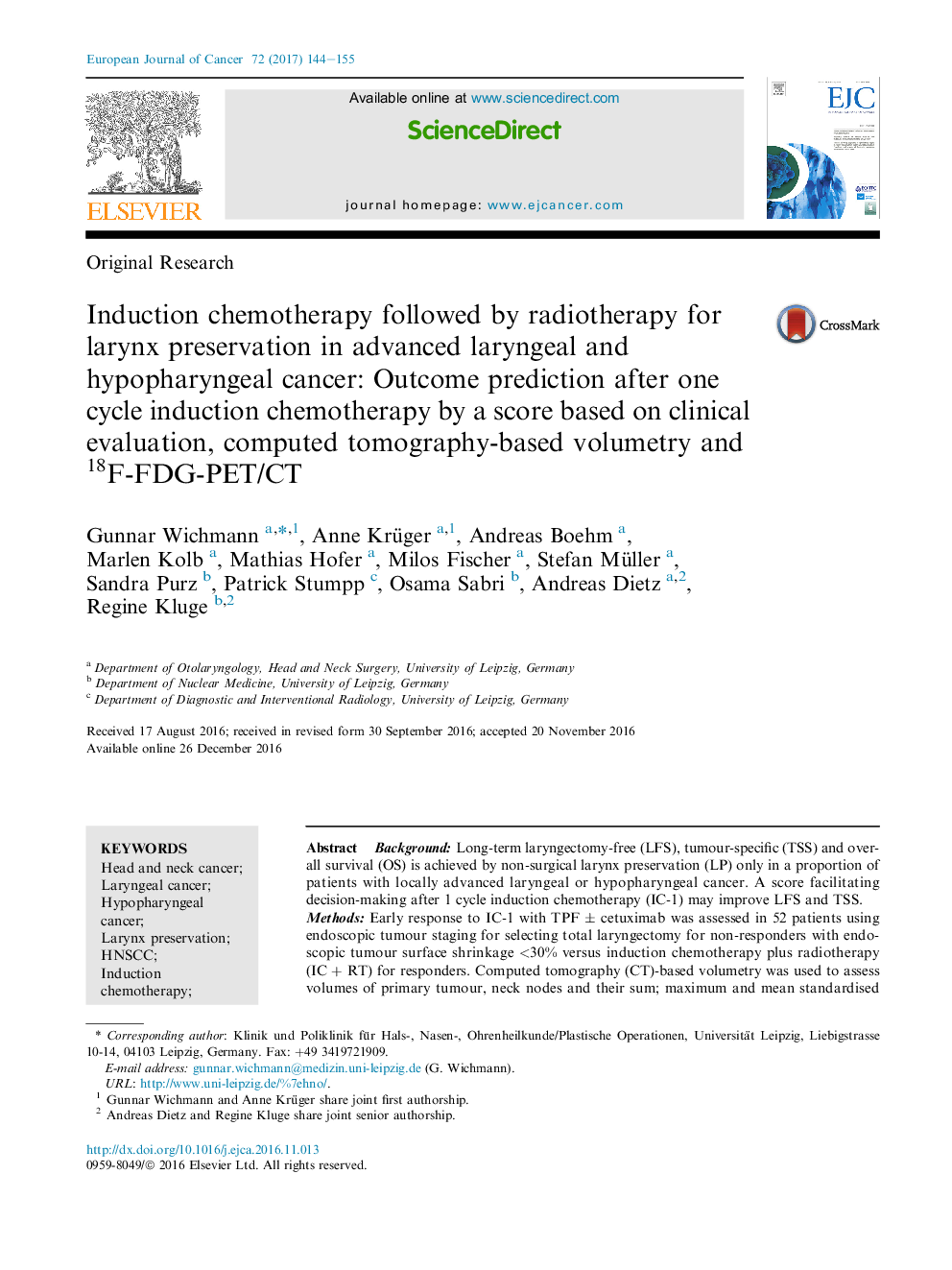| کد مقاله | کد نشریه | سال انتشار | مقاله انگلیسی | نسخه تمام متن |
|---|---|---|---|---|
| 5526314 | 1547060 | 2017 | 12 صفحه PDF | دانلود رایگان |

- Larynx preservation (LP) in advanced larynx/hypopharynx squamous cell carcinoma (LHSCC) features uncertainties.
- After 1 cycle induction chemotherapy (IC-1) endoscopic response assessment of tumour surface shrinkage (ETSS) is recommended.
- This is the largest study in advanced LHSCC comparing ETSS, CT-volumetry and PET/CT after IC-1 in a prospective LP trial.
- Hazard ratios of 4 independent predictors define a new score for laryngectomy-free survival (LFS), the LFS-score.
- Responders with ETSS ⥠30% and LFS-score â¤16 achieve prolonged LFS, tumour-specific and overall survival.
BackgroundLong-term laryngectomy-free (LFS), tumour-specific (TSS) and overall survival (OS) is achieved by non-surgical larynx preservation (LP) only in a proportion of patients with locally advanced laryngeal or hypopharyngeal cancer. A score facilitating decision-making after 1 cycle induction chemotherapy (IC-1) may improve LFS and TSS.MethodsEarly response to IC-1 with TPF ± cetuximab was assessed in 52 patients using endoscopic tumour staging for selecting total laryngectomy for non-responders with endoscopic tumour surface shrinkage <30% versus induction chemotherapy plus radiotherapy (IC + RT) for responders. Computed tomography (CT)-based volumetry was used to assess volumes of primary tumour, neck nodes and their sum; maximum and mean standardised uptake value (SUVmax, SUVmean) were measured by 18F-FDG-PET/CT. Baseline and residual values after IC-1 were calculated and correlated with LFS, TSS and OS.ResultsAfter IC-1, 39/52 patients (75%) were early responders. Early response predicted complete response to IC + RT (p = 8.48 Ã 10â9). Early laryngectomised non-responders and responders with endoscopic tumour surface shrinkage > 70% had best OS. Significant independent predictors for LFS in responders are number of CT-staged suspect positive neck nodes (N+), residual primary tumour volume, residual total tumour volume and the ratio of residual SUVmax and SUVmean (resSUVmax/resSUVmean). Our LFS-score combines >2N+, residual primary tumour volume > 20%, residual total tumour volume > 5.6 mL and resSUVmax/resSUVmean > 1.51 weighted by their hazard ratio (12, 6, 5 and 4); LFS-score â¤Â 16 predicts increased LFS, OS and TSS (p < 0.05).ConclusionLFS-score â¤Â 16 identifies in responders to IC-1 the patients with maximum benefit of non-surgical LP achieving long-term LFS. Even more importantly, a LFS-score > 16 defines patients unsuitable for LP applying the TPF/TP IC + RT protocol.
Journal: European Journal of Cancer - Volume 72, February 2017, Pages 144-155